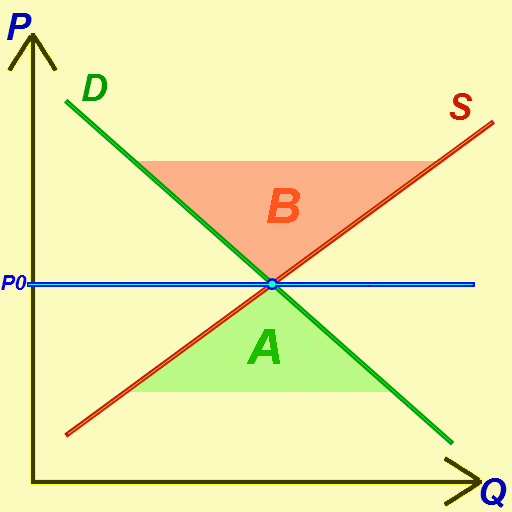So, it's been a while since my last post here, for which I apologize. I've been caught up in running my business and getting through to the end of my last semester at college.
Anyways. In my last post I examined the relation between competitiveness in markets and socially optimal market structure. Now I shall be doing the same sort of thing with markets that contain externalities, tossing in market equilibrium and a few other ideas.
First of all, let's get a clear idea of what market equilibrium is. I'm sure most of you know that you can construct supply and demand curves for any market. The demand curve shows how much people are willing to purchase at a particular price, and it decreases as price increases; similarly, the supply curve shows how much the producers in the market are willing to provide at a certain price, and it increases as price increases.
The graph of these curves, which most of you probably already know in a vague sort of sense, looks something like this...
That point where the two lines cross is called market equilibrium. This is the point at which the amount supplied and the amount demanded is equivalent; that is, there is no shortage and no surplus, as are indicated by the B and A quadrants.
More importantly than this, it is generally the case that utility is maximized at equilibrium. This occurs because consumer and producer surplus are maximized. Consumer surplus is the triangle above the blue line and below the green line on the above graph; it represents the utility gained by consumers who would be willing to pay a higher price, but instead only have to pay the equilibrium price. Similarly, producer surplus is the utility gained by producers when they can sell a unit of a good that they would provide at a lower price at a higher price, and is the area above the red line but below the blue one in the above graph.
The total area of consumer and producer surplus is maximized at equilibrium, which you can simply take my word on, work out by moving things around on the graph, or figure out mathematically with integrals or somesuch. For the moment, we will simply move over this point and continue on, with one exception: the loss of surplus as a result of moving away from equilibrium is called dead-weight loss, and will be referred to later.
When a market contains an externality of some type, what is really occurring is a divergence between social and private demand or supply. That is, the fact that the transaction in question has some impact on others is not factored into the demand and supply of individuals, but it is factored into the demand and supply preferred by society.
As an example, the social supply curve for a good whose production involves pollution is lower than the private supply curve, as the cost of the pollution is spread over everyone affected, not only those involved in the transaction. In an unfettered market, the equilibrium reached would then be one of personal utility maximization, as opposed to social utility maximization.
On the graph, this boils down to have two supply curves, rather than one - one social, one private. We can treat the social supply curve as the 'true' demand curve, while the private one is considered to be maladjusted. It can then be said that the equilibrium point created by the private supply curve creates dead-weight loss from the point of view of society, whose supply curve is different. This results in a net loss of utility for society as a whole.
This problem cannot be fixed within the confines of the market.
Let me say that again: the problem cannot be fixed simply by changing the market in some way. The only way to cause a convergence of the social and private supply curves is for some external agency to make it happen, usually through taxation or direct regulation. Regardless, the entity that performs this service in the vast majority of cases is the government.
Externalities then represent one instance in which the market will reach a socially non-optimal equilibrium without some attempt by an outside agency to bring private demand and supply in line with social demand and supply.
And that was significantly easier to write than my last post. Hopefully it was easier to understand, as well, but we shall see. Even more hopefully, I'll probably be back to updating once or twice a week over the next few weeks!
Comments, questions, suggestions, and other nonsense should be left below. I appreciate any feedback you have for me, as this is written for the rest of you just as much as it is for me.

No comments:
Post a Comment